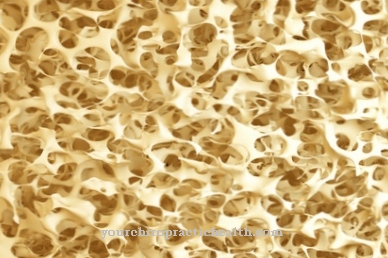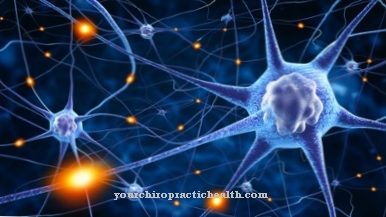The Fatty acid synthesis includes the multi-stage synthesis of fatty acids for the purpose of energy storage in the organism. It represents only part of the fat metabolism, which in turn is integrated into the overall metabolism. Under normal dietary conditions, fatty acid synthesis is of less importance to humans, since the diet already contains fats.
What is fatty acid synthesis?

Fatty acid synthesis is also known under the scientific name lipogenesis. It represents an anabolic, assimilating metabolic process that serves to store energy reserves for the organism. This applies to bacteria and fungi as well as to plants and animals.
Lipogenesis is based on the presence of several important starting compounds, vitamins and enzymes. Malonyl-CoA, which is formed from acetyl-CoA by carboxylation (addition of carbon dioxide) under enzymatic conditions, plays a central role in the synthesis. Acetyl-CoA comes from different metabolic pathways. It occurs as an intermediate product in glycolysis (sugar metabolism), in the breakdown of fatty acids or in protein metabolism. With the help of enzymes (acetyl-CoA carboxylase, fatty acid synthetase), energy transmitters (ATP, ADP) and vitamins (biotin, pantothenic acid), the fatty acid synthesis is then controlled.
Function & task
The storage of energy is very important for the survival of any organism. Fatty acid synthesis emerged as an ideal way of storing energy at an early stage in evolution. The fatty acids are stored in esterified form as fats or oils in certain cells provided for this purpose. Other fatty acid esters are also of great importance in the construction of cell membranes.
To produce energy storage devices, the fatty acids are esterified with the trihydric alcohol glycerol. They are esterified with phosphorus-containing compounds in cell membranes. Furthermore, fatty acids form the basis for the synthesis of cholesterol and various hormones (sex hormones, glucocorticoids, mineralocorticoids).
Chemically, they represent long-chain molecules with a carbon chain and a carboxyl group. Sometimes the chain is also branched. Occasionally, double bonds may also be present in the carbon chain. Then it is unsaturated fatty acids. Saturated fatty acids only contain single bonds.
These small structural differences are responsible for the multitude of possible functions of this group of substances. However, their main function is to store energy.The starting substances for fatty acid synthesis are produced via every metabolic pathway. Acetyl-CoA is always formed as an intermediate product from carbohydrates, proteins and fats when they are broken down. In the mitochondria, acetyl-CoA is broken down into carbon dioxide and water while generating energy.
However, it can also be used in the cytoplasm for the new synthesis of fatty acids. To do this, it is first converted into malonyl-CoA and ADP with the help of ATP, with carboxylation and energy absorption. Malonyl-CoA in turn is subject to an enzymatic condensation with acetyl-ACP. The resulting butyryl-ACP is again condensed with malonyl-CoA. These condensations are repeated until fatty acids with a chain length of up to 16 carbon atoms have been produced.
Under normal conditions, fatty acid synthesis is of only minor importance in humans. One of the reasons for this is that the food usually contains a sufficiently large proportion of fat. In this way, the fats present in the food are broken down into fatty acids and, if necessary, re-esterified into fat. Furthermore, with a balanced diet, energy supply and energy requirements are balanced.
In the past, however, there was often phases of hunger, so that the body had to take in more energy in the form of food when there was too much food in order to store fat reserves for times of need. The same is still true today for animals that have to hibernate to survive the winter. For them, fatty acid synthesis is of great importance because they are also dependent on carbohydrate-rich food to build up fat reserves.
Illnesses & ailments
In connection with health problems, both excessive and insufficient fatty acid production play a major role. Today, diet-related diseases are becoming more common. In times of food surplus, the number of overweight or even obese people increases more and more. As a result of a high-calorie and high-carbohydrate diet, fatty acid synthesis is boosted in the body.
Normally, the biosynthesis of fatty acids should only play a subordinate role today. But overeating is common due to excessive food, stress or mental health problems.
The resulting obesity poses major challenges for the healthcare sector. Secondary diseases are for example diabetes mellitus, arteriosclerosis, cardiovascular diseases, dementia or other degenerative diseases.
This trend can only be countered through a healthy lifestyle with low-carbohydrate food and physical activity. In addition, energy consumption and energy consumption should be in balance again.
The hormone insulin controls the absorption of glucose into cells for energy production. However, when less energy is used than is given off, insulin is responsible for boosting fatty acid synthesis. In this case, the glucose is channeled into the fat cells, where the new formation of fatty acids begins immediately.
The more the adipose tissue is filled with fat, the less effective the insulin becomes. Complicated metabolic processes reduce the number of insulin receptors on cell membranes. The result is an increase in the blood sugar level and an increase in insulin production until it may cease completely. Fatty acid synthesis also comes to a standstill. To generate energy, lipolysis in the fat cells increases with increased ketone formation, which over-acidifies the blood and can lead to a diabetic coma.












.jpg)



.jpg)










.jpg)
